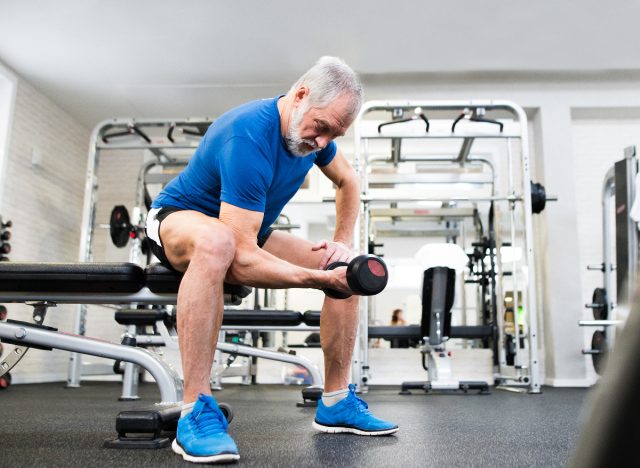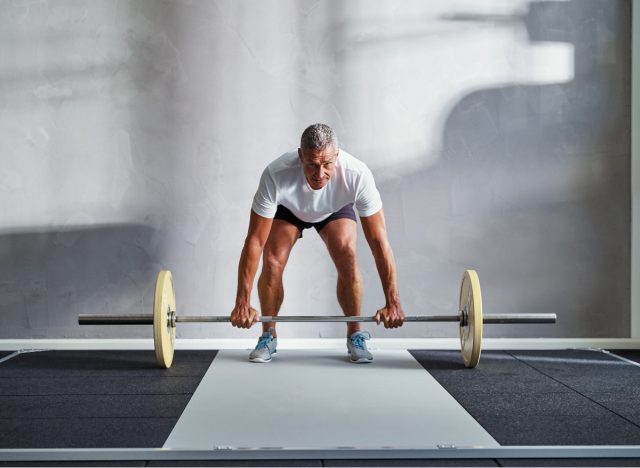Over 50? Avoid These 6 Common Strength Training Mistakes

Strength training is an essential fitness tool to maintain lean muscle and stay active and fit as you enter your 50s and beyond. That being said, certain common strength training mistakes can completely derail your progress or cause injury. From neglecting warm-ups and cool-downs to lifting too heavy before you're really ready, a fitness pro calls out these common errors and how to avoid them.
"Strength training is incredibly important as we age because inevitably our biological systems start to decline," explains Michael Cummings, director of education, BlazePod. "Having a solid resistance training regimen, especially after the age of 50, should be mandatory, as it will preserve muscle mass, boost metabolism, improve bone health, increase balance and stability, enhance joint health, and improve overall functional movement efficiency."
Now, let's explore six common strength training mistakes and how to avoid them after 50, according to Cummings' first-hand experience he's seen in 25+ years as a fitness professional.
Neglecting Warm-Ups and Cool-Downs

As you age, your joints and muscles require more time to warm up and recover. Skipping out on a solid warm-up and cool-down can heighten your risk of sprains, strains, soreness, and injury.
How To Avoid It:
Don't sleep on a proper warm-up and cool-down!
"Always start your workout with at least five to 10 minutes of light cardio to increase your body temp," Cummings stresses. "Follow it up by foam rolling the muscles you are about to train to hydrate them. End your warm-up with relevant dynamic stretches to prepare your muscles for movement."
In addition, be sure to wrap up your workout with five to 10 minutes of stretching, light cardio, and massage to boost flexibility and decrease soreness.
Lifting Too Heavy Before Your Body Can Handle It

It's easy to try to lift heavy weights or stick to the weight you lifted when you were younger. "You must lose the ego and set new intentions," says Cummings. "This isn't to say that you won't get there again or surpass where you once were; it's just that jumping into heavy lifting without proper preparation is one of the biggest factors for injury."
How To Avoid It:
Cummings recommends starting out with lighter weights and higher reps to ensure your technique and form are perfect. Then, slowly increase the weight and decrease the reps as you get stronger.
"Focus on mastering the big movements (squat, deadlift, bench press, etc.) and compound movements (Turkish get-ups, thrusters, burpees, etc.) regularly," Cummings stresses.
Inconsistency

Consistency is the name of the game if you want to achieve noticeable results.
"Rome was not built in a day," says Cummings. "At age 46, I can thank my randomly occurring back pain for not following this one. Strength training should be seen as a marathon and not a sprint. Your muscles need regular stimulus to grow stronger. The key is to train smart and be consistent."
How To Avoid It:
Make it your mission to train with resistance at least two to three times a week. Being consistent with your efforts is essential for muscle growth and maintenance.
"Set a schedule that works for you, and prioritize strength training as part of your fitness routine," suggests Cummings. "Track your progress, which can help keep you motivated and hold you accountable. A workout partner is also a great way to keep you on track longer."
Ignoring Recovery

Carving out time for rest and recovery is just as crucial as your time at the gym.
"After 50, recovery time between strength training sessions might need to be longer," Cummings tells us. "Overworking muscles can lead to fatigue and injury. Sleep is where all the fountain of youth hormones are released, so make sure rest and sleep are factored into your recovery session."
How To Avoid It:
Cummings recommends giving yourself 48 hours of rest between strength training workouts that engage the same muscle group. In addition, get solid sleep—seven to nine hours each night—to support muscle growth and repair. Implement active recovery days, such as low-impact exercises like biking, walking, or swimming, on days you aren't strength training.
Poor Form and Technique

"The rule I always coach is that if you can't perform the movement perfectly with your own body weight, you're not ready to add any resistance to the movement," Cummings tells us. "Incorrect technique can lead to injury, especially in exercises like squats, deadlifts, or overhead presses."
How To Avoid It:
Be mindful of perfecting your form without using weights first, then move into lifting lighter weights and performing more reps. "Consider working with a certified personal trainer or strength coach who has experience working with older adults to ensure you're performing exercises correctly," Cummings suggests.
You can also do your workouts in front of a mirror or record yourself to check your form.
Focusing On Strength Training Only

While strength training is important as you age, don't forget about flexibility, balance, and mobility exercises. Neglecting them can cause muscle imbalances.
"After 50, these components become even more important for preventing falls and improving overall movement quality," Cummings stresses.
How To Avoid It:
Perform exercises that boost your balance, such as slack board training, single-leg movements, and working out on unstable surfaces. Incorporate mobility exercises like stretching and foam rolling to preserve your joint health. In addition, work on exercises that improve your core stability and functional movements, which support how well you perform daily activities.









